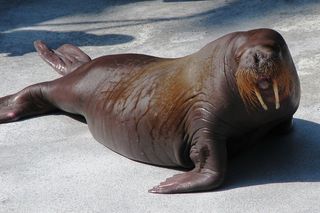In Biology, Bigger Is Better

One might think organisms that aren't too small, nor too big, but are just the right size for the environment to which they've adapted might have the best chance of survival. Not so. In evolution, "just right" means squat. Bigger is almost always better.
That conclusion follows from a new meta-study a study of the results of other studies by researchers at the National Evolutionary Synthesis Center in Durham, NC. Biologists Joel Kingsolver and Sarah Diamond analyzed papers about natural selection in 100 different plant and animal species. They found that larger specimen size and earlier blooming, breeding , or hatching (as the case may be) confer significant survival and reproductive advantages. "It's a very widespread pattern," Kingsolver said in a press release.
The researchers explained that their finding starkly contradicts what seems intuitively correct namely, stabilizing selection, also known as the 'Goldilocks' model of evolution . This predicts that mid-sized specimens would be the best survivors, because they're likely to be the best adapted to their particular circumstances. Human babies, for example, are healthiest when they're mid-sized, rather than overly large or small.
But such cases are the exception rather than the rule in evolution. "Rarely is it the case that the individuals that survive and reproduce the best are the ones in the middle," Kingsolver said.
The researchers believe there might be different reasons for this fact in different circumstances, and they've explained their hypotheses in the March issue of American Naturalist. Sometimes, size and flashiness might help a specimen reproduce, even though it puts it in greater environmental danger. For other species, their environment may be too changeable to produce a "just right" size in the first place. And in other cases, something called "correlated selection" may play a role, tying greater body size to other survival advantages.
But whatever the reason, the message is this: In nature, the middleman seldom makes it to the end of the horror film. And before he goes down, he doesn't get the girl either. He's always losing out to his bigger friend.
- Are Any Animals Monogamous?
- Ape or Human? Fossils' Link to Evolution Questioned
- What's the Missing Link?
Got a question? Send us an emailThis e-mail address is being protected from spambots. You need JavaScript enabled to view it This e-mail address is being protected from spambots. You need JavaScript enabled to view it This e-mail address is being protected from spambots. You need JavaScript enabled to view it This e-mail address is being protected from spambots. You need JavaScript enabled to view it This e-mail address is being protected from spambots. You need JavaScript enabled to view it This e-mail address is being protected from spambots. You need JavaScript enabled to view it and we'll crack itThis e-mail address is being protected from spambots. You need JavaScript enabled to view it . Follow Natalie Wolchover on Twitter @nattyover
Sign up for the Live Science daily newsletter now
Get the world’s most fascinating discoveries delivered straight to your inbox.
Natalie Wolchover was a staff writer for Live Science from 2010 to 2012 and is currently a senior physics writer and editor for Quanta Magazine. She holds a bachelor's degree in physics from Tufts University and has studied physics at the University of California, Berkeley. Along with the staff of Quanta, Wolchover won the 2022 Pulitzer Prize for explanatory writing for her work on the building of the James Webb Space Telescope. Her work has also appeared in the The Best American Science and Nature Writing and The Best Writing on Mathematics, Nature, The New Yorker and Popular Science. She was the 2016 winner of the Evert Clark/Seth Payne Award, an annual prize for young science journalists, as well as the winner of the 2017 Science Communication Award for the American Institute of Physics.
Most Popular


